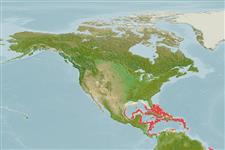>
Ovalentaria/misc (Various families in series Ovalentaria) >
Opistognathidae (Jawfishes)
Etymology: Opistognathus: Greek, opisthe = behind + Greek, gnathos = jaw (Ref. 45335); to the very elongate upper jaw of the type species of the genus, Opistognathus nigromarginatus (Ref. 128653); leprocarus: From the Greek 'lepros' meaning scaly and 'kara' meaning head, in reference to the well developed cephalic squamation (Ref. 26893).
Environment: milieu / climate zone / depth range / distribution range
Ecologia
marino batidemersale; distribuzione batimetrica 165 - 308 m (Ref. 26893). Deep-water
Western Central Atlantic: known only from the Bahamas and the Lesser Antilles, including Anegada Passage, between Virgin Islands and Anguilla (ANSP 138563).
Size / Peso / Age
Maturity: Lm ? range ? - ? cm
Max length : 8.1 cm SL maschio/sesso non determinato; (Ref. 26893)
Spine dorsali (totale) : 10 - 11; Raggi dorsali molli (totale) : 11 - 13; Spine anali: 3; Raggi anali molli: 11 - 12; Vertebre: 26. Anterior nostril a short tube without cirrus on posterior rim; posterior end of maxilla rigid, without thin flexible lamina; opercle with prominent wedge-shaped dark blotch; buccal cavity and inner lining of maxilla and adjacent membranes immaculate; dorsal fin spines slender, straight, with rigid sharp tip; nape completely scaled; cheeks with 4 or 5 rows of scales; segmented anal fin rays 11 or 12; caudal vertebrae 16; pelvic fins elongate in adults 39-49% SL with tip of depressed fin extending posteriorly well past anal fin origin (Ref. 26893).
Observed using shells and rubble to close their burrow opening (Ref. 26893).
Life cycle and mating behavior
Maturities | Riproduzione | Spawnings | Egg(s) | Fecundities | Larve
Smith-Vaniz, W.F., 1997. Five new species of jawfishes (Opistognathus: Opistognathidae) from the western Atlantic ocean. Bull. Mar. Sci. 60(3):1074-1128. (Ref. 26893)
IUCN Red List Status (Ref. 130435)
Threat to humans
Harmless
Human uses
Strumenti
Special reports
Download XML
Fonti Internet
Estimates based on models
Preferred temperature (Ref.
123201): 14 - 22.7, mean 19 °C (based on 16 cells).
Phylogenetic diversity index (Ref.
82804): PD
50 = 0.5000 [Uniqueness, from 0.5 = low to 2.0 = high].
Bayesian length-weight: a=0.00389 (0.00180 - 0.00842), b=3.12 (2.94 - 3.30), in cm total length, based on all LWR estimates for this body shape (Ref.
93245).
Trophic level (Ref.
69278): 3.4 ±0.6 se; based on size and trophs of closest relatives
Fishing Vulnerability (Ref.
59153): Low vulnerability (10 of 100).
